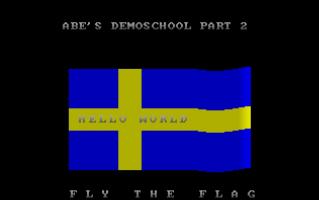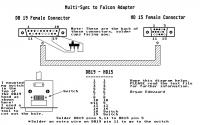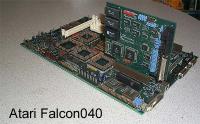Fade to black: fading techniques on the atari falcon
BY MR PINK / RESERVOIR GODS
One of the oldest presentation effects is the fade. One graphical screen fades out, the next one fades in. This effect has been used extensively on all computers, but hasn't been seen on the Falcons true colour mode as up until recently it was thought impossible.
For the non coders I will try to give an explanation of fading. In 16 and 256 colour mode you have a number of paletter registers and you just need to change that palette register and the all pixels on screen assigned to that register will change. So to change all colours on a 16 colour screen you need just to change 16 registers, on a 256 colour screen 256 registers must be changed.
On a true colour screen things are different. There is no palette - each pixel is completely independent from every other pixel on the screen. To fade a screen down you have to change EVERY single pixel. This means reading in every pixel, isolating the RGB values and fading them then combing them to make a new colour and writing the pixel back. On a low res screen of 320x240 this means 76,800 pixels have to be calculated and unfortunatel there is no where near enough processor time to do this in one VBL.
Consequently you don't see fades so often on the Falcon. Screens will hardware scroll off (a technique I used on the intro screens of Tautology 2) or be cleared a couple of pixels at a time.
But there has been a breakthrough and true colour fading is now possible on the Falcon! This comes through a lot of clever fiddling with the hardware, and some slight reprogramming of the VIDEL.
This effect was discovered by Aggression, and told to me by Evil of Dead Hackers Society. It is an effect I had noticed but not realised. The early versions of God-paint, although running in true colour mode, had a white border, that is colour 0 of the falcon palette was white. I noticed that graphics on my monitor looked a lot darker than on Ripley's SVGA monitor. I changed the background colour to black and graphics appeared lighter. I assumed this was just something to do with the glare of the white light making the other graphics appear dimmer, but it is more subtle than that.
There is a hidden feature of the VIDEL whereby you can control the intensity of a true colour screen by altering the value of the background colour register. You must clear the videl's horizontal border end register at the start of every VBL, then poke the falcon palette register 0. For a full intensity screen the value of $ffff9800 must be 0. For a dark screen the value of $ffff9800 must be $FFFF00FF.
To fade you simply interpolate between these two values.
A quick example of the code:
moveq #0,d7 ;full intensity
fade move.w #$25,-(a7) ;wait vbl
trap #14
addq.w #2,a7
clr.w $ffff8286.w ;clear hbe
moveq #0,d0
bfins d7,d0{0:6} ;set red
bfins d7,d0{8:6} ;set green
bfins d7,d0{24:6} ;set blue
move.l d0,$ffff9800.w ;set palette register
addq.w #1,d7 ;dec intensity
cmp.w #64,d7 ;lowest intensity reached?
blt.s fade ;no, loopThere are some disadvantages with this effect.
The first is that you can't fade to black, the lowest intensity is a dark grey. You can get past this problem by quickly screen swapping to a black screen when you reach dark grey.
Also the border colour increases as the main picture decreases, and this looks a bit messy.
Also this effect doesn't work on VGA monitors, though apparently DHS have come up with a hack to get this working. If you manage to get this working on other monitors, let us know!
If you have any programming queries or programming tips, please write to us at:
- Maggie Programming Forum
- Cwm Isaf
- Abermule
- Montgomery
- Welshpool
- Powys
- SY15 6JL
If you have any info on these issues, please let us know:
- Transferring between main memory and the DSP via the Blitter
- Synchronising Timer B whilst using other interrupts
- Non-flickering palette switching on bitplane modes
Pterm() until next issue!































